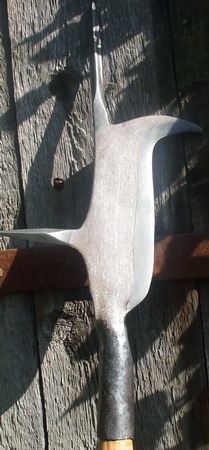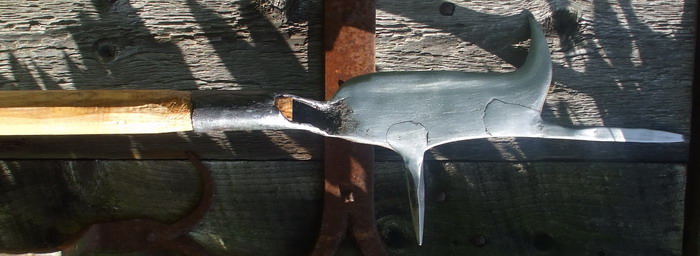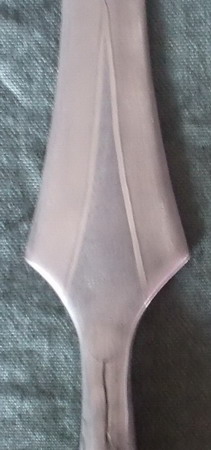|
Pole Arms
Below you will find some examples of the pole arms I have made. They are supplied either as full length weapons including ash wood shaft, or just as the head. Shafted Pole arms, because of their length, pose a difficulty with expense and ease of shipping/posting. TNT couriers have to be used, as the post office and other couriers will not take them.
I forge rather than fabricate these heads. Fabricated laser cut mild steel plate mig welded to a partially squashed tube does not do the job for museum quality displays and interpretations. Where applicable, I like to make the various heads from wrought iron, keeping the better quality carbon steel for the edges and points. The effect can be further heightened by acid dipping the article, which shows up the grain differences of the two materials (see the English Bill below).
At the time of writing, I feel many living history groups neglect the humble pole arm in their displays, and many collectors do not recognize them as having the aesthetic qualities of the sword. Hopefully, I can try to change these attitudes.
English Military Bill
|
 |
 |
An English military bill in use from the 14th to the 16th centuries. Forged in iron with a steel edge, top and back spike. This weapon was used to arm the backbone of the infantry in England until the pike and musket era and carried on being used by militia into the late 16th, well after it's official obsolescence . It was very cheap,crude and easy to make. Adapted from an agricultural hedge/wood cutting tool the addition of a top and back spike created a military infantry weapon which armed the shock component of English infantry (the more celebrated longbow arming the archers who were the missile arm of the infantry). This sort of weapon was well within the capabilities of a village smith to make and it's cheapness and availability explains its longevity.
Prices from £375
|
|
|
|
Mid Saxon Spearhead
|
 |
 |
This is a pattern welded Saxon spear head with an iron core and socket. The blade has a pattern welded core boundry and carbon steel edges. The blade is leaf shaped and it is mounted on an ashwood shaft.
Prices from £270
|
|
|
|
Anglo Saxon Pattern Welded Spearhead
|
 |
 |
An English (Anglo Saxon) spearhead typical of 9th and 10th century examples. It has a split iron socket and an iron core with pattern welded boundaries and carbon steel edges. The split socket, whilst unsightly to modern eyes, seams to be a typical feature of Anglo Saxon (English) spear heads from the early 6th century to the mid 11th century. They are easier to make than a fully welded socket and more economical in the use of iron. There doesn't seem to be any disadvantage in their function as against a fully welded socket.
Prices from £270
|
|
|
|
6th Century Anglo Saxon Spearhead
|
 |
 |
A Swansons Type H2 spearhead - typical 6th century Anglo Saxon. It has a split iron socket which extends into an iron core. A phosphoric iron strip delineates the weld boundary between the core and the carbon steel edges. Many heads of this period were made from plain layered iron with no steel edges. This spear head is a well constructed, high quality example of this type.
Prices from £195
|
|
|
|
Frankish Winged Spearhead
|
 |
 |
This is a Frankish winged spearhead. It has a layered iron core and socket with carbon steel edges. It was the typical weapon of the heavy infantry during of the 10th/11th century.
Prices from £270
|
|
|
|
|










